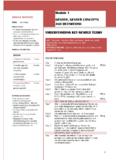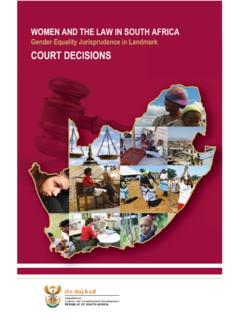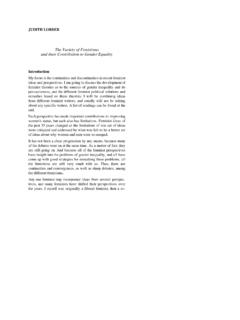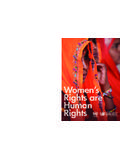Transcription of CMIN 2013 5-E - OECD.org
1 2 THE COUNCIL, HAVING REGARD to Article 5 b) of the Convention on the Organisation for Economic Co-operation and Development of 14 December 1960; HAVING REGARD to the 1976 Recommendation of the Council on a General Employment and Manpower Policy, for "creating and maintaining employment and improved conditions of working life for all those who are able and want to work, with the support of relevant economic, employment, manpower and social policies [C(76)37]; HAVING REGARD to the 1978 Declaration by OECD Ministers of Education, and in particular to their statement that one of the aims deserving priority consideration was "to adopt positive educational measures which contribute to the achievement of equality between girls and boys, women and men" [ED/MIN(78)4/FINAL]; HAVING REGARD to the 1980 Declaration on Policies for the Employment of Women of the High Level Conference on the Employment of Women of OECD Member countries [C(80)76].
2 To the 1999 OECD Development Assistance Committee Guidelines for gender equality and Women s Empowerment in Development Co-operation [DCD/DAC(97)25/REV2] and, to the 2008 OECD Development Assistance Committee Guiding Principles for Aid Effectiveness, gender equality and Women s Empowerment [DCD/DAC/GEN(2008)1/REV3]; HAVING REGARD to the OECD framework for gender mainstreaming in its own Programme of Work and Budget [C(2001)173]; HAVING REGARD to the recommendations of the 2011 update of the OECD Guidelines for Multinational Enterprises to fight gender discrimination in employment [C/MIN(2011)11/FINAL]; HAVING REGARD to the 2005 Recommendation of the Council on Principles and Good Practices for Financial Education and Awareness [C(2005)55/REV1]; WELCOMING the significant foundation already provided by several international instruments on various aspects of gender equality , notably the UN Millennium Development Goals (MDGs); the 1995 Beijing Declaration and Platform for Action of the Fourth UN World Conference on Women; and the principles embodied in the UN Convention on the Elimination of all Forms of Discrimination against Women (CEDAW) of 1979.
3 WELCOMING the reports delivered by the OECD gender Initiative Report on the gender Initiative: gender equality in Education, Employment and Entrepreneurship 2011 [C/MIN(2011)10/FINAL] and gender equality in Education, Employment and Entrepreneurship: Final Report to the MCM 2012 [C/MIN(2012)5] and recommending its consideration by Members and Partners in developing their policies to achieve gender equality in education, employment and entrepreneurship; CONSIDERING that important steps have already been taken by governments, the private sector, social partners and non-governmental organisations to combat gender inequality in economic opportunities by introducing anti-discrimination laws in workplaces and society; legislating employment-protected parental, maternity and paternity leave; implementing family-friendly policies at work; and, tackling stereotyping in school through educational programmes; CONSIDERING that significant gender disparities and biases nevertheless remain in educational and occupational choices; earning levels; working conditions; career progression; representation in decision- 3making positions.
4 In the uptake of paid and unpaid work; in entrepreneurial activities; in access to finance for entrepreneurs; and in financial literacy and financial empowerment; RECOGNISING that strong and effective actions by all actors are needed in both the public and private sectors to remove the remaining persistent obstacles to gender equality in education, employment and entrepreneurship and to measure and monitor the progress in achieving this goal together, including by supporting the efforts of developing and emerging countries; RECOGNISING that further commitment by Members and Partners to improve gender equality in education, employment and entrepreneurship will contribute not only to greater equality of opportunities for men and women but also to strong and sustainable economic growth as the full potential of women will be taken advantage of; HAVING REGARD to the 2012 Meeting of the OECD Ministerial Council that mandated the relevant committees to develop a Recommendation on gender equality in Education, Employment and Entrepreneurship to replace the OECD 1980 Declaration on Policies for the Employment of Women [C/MIN(2012)19 and C/M(2012)7, Item 104 c)].
5 On the proposal of the Employment, Labour and Social Affairs Committee in consultation with other competent OECD committees: I. RECOMMENDS that through a whole-of-government approach and through means such as appropriate legislation, policies, monitoring and public awareness campaigns, Members: A. adopt practices that promote gender equality in education by: 1. ensuring that boys and girls have equal access to good-quality education, equal rights and opportunities to successfully complete schooling and in making educational choices; 2. reviewing and where necessary adapting school and early childhood education curricula, teaching and school practices to eliminate gender discrimination and stereotyping; 3.
6 Making the study of science, technology, engineering, mathematics (STEM) financial and entrepreneurship issues, as well as education, arts and the humanities, equally inclusive and attractive for both boys and girls; promoting the development of stronger reading habits among boys and girls; 4. campaigning and raising awareness among young men and women, parents, teachers and employers about gender -stereotypical attitudes towards academic performances and the likely consequences of overall educational choices for employment and entrepreneurship opportunities, career progression and earnings; 5. encouraging more women who have completed STEM studies to pursue professional careers in these areas, for example by means of career counselling, adult education, internships, apprenticeships and targeted financial support; B.
7 Promote family-friendly policies and working conditions which enable fathers and mothers to balance their working hours and their family responsibilities and facilitate women to participate more in private and public sector employment by: 1. designing tax-benefit systems so that both parents have broadly similar financial incentives to work; 42. securing availability of and access to affordable good-quality early childhood education and care as well as affordable long-term care for other dependants, including for example disabled children or elderly relatives; 3. providing employment-protected paid maternity and paternity leave to working mothers and fathers; 4. encouraging working fathers to take available care leave, for example by reserving part of the parental leave entitlement for the exclusive and non-transferable use by fathers; 5.
8 Providing incentives to fathers to use flexible work entitlements, promoting a more temporary use of part-time work among men and women, providing incentives for women to participate more hours in the labour force, and raising awareness of gender stereotypes to encourage a more equal sharing of paid and unpaid work (household responsibilities) between men and women; 6. ensuring that all parents can participate in the labour market regardless of their partnership status, providing ample employment supports to sole parents; 7. ensuring that policies that address the problem of unemployment do not discriminate either directly or indirectly against women; 8. improving employment conditions and access to social support for informal workers, especially those in the most vulnerable categories such as home-based and domestic workers; C.
9 Increase the representation of women in decision-making positions by: 1. encouraging measures such as voluntary targets, disclosure requirements and private initiatives that enhance gender diversity on boards and in senior management of listed companies; complementing such efforts with other measures to support effective board participation by women and expand the pool of qualified candidates; continuing to monitor and analyse the costs and benefits of different approaches including voluntary targets, disclosure requirements or boardroom quotas to promote gender diversity in leadership positions in private companies; 2. introducing mechanisms to improve the gender balance in leadership positions in the public sector, such as disclosure requirements, target setting or quotas for women in senior management positions; strengthening the flexibility, transparency and fairness of public sector employment systems and policies; and monitoring progress of female representation in the public sector; 3.
10 Encouraging greater participation and representation of women at all levels of politics, including in government, parliament, local authorities, and the judiciary system; D. eliminate the discriminatory gender wage gap by: strengthening the legal framework and its enforcement for combating all forms of discrimination in pay, recruitment, training and promotion; promoting pay transparency; ensuring that the principle of equal pay for equal work or for work of equal value is respected in collective bargaining and/or labour law and practice; tackling stereotypes, segregation and indirect discrimination in the labour market, notably against part-time workers; promoting the reconciliation of work and family life; E.
















